
Preservation Self-Assessment Program
Videotape
Open Reel Video
This moving image format type consists of magnetized particles embedded on a polyester tape carrier. This format type is called "open reel" because the magnetic tape is not enclosed in a plastic cassette.
- 2" Open Reel (1956 - early 1980s)
- 1" Open Reel (1963 - mid 1990s)
- ½" Open Reel (1965 - early 1990s)
Cassette / Cartridge-Based Video
This moving image format type consists of magnetized particles embedded on a polyester tape carrier. The magnetic tape is contained within a plastic cassette or cartridge.
- U-matic / U-matic SP (1971 - c. 2000) / (1986 - c. 2000)
- Betamax (1975 - late 1980s)
- VHS / S-VHS (1976 - present) / (1987 - late 1990s)
- Betacam / Betacam SP (1982 - present) / (1986 - present)
- Video8 / Hi8 (1984 - late 2000s) / (1989 - 2007)
- D-2 (1988 - 2000s)
- D-3 (1991 - present)
- Digital Betacam (1993 - present)
- MiniDV (1995 - late 2000s)
- DVCPRO (1995 - present)
- DVCAM (1996 - present)
- Other digital video
2" Open Reel
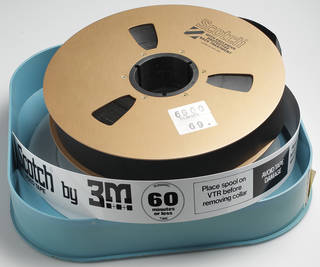
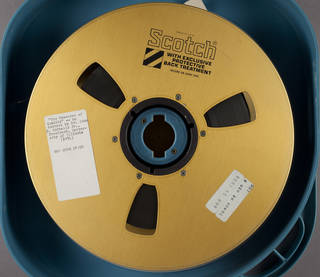
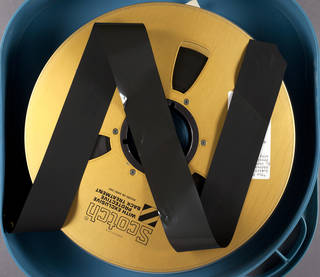
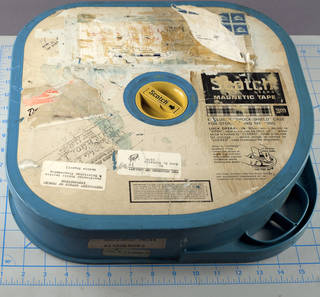
- Synonym
-
- 2" Quadruplex
- Dates
- 1956 – early 1980s
- Common Size(s)
- Tape width: 2"
- Reel: ~12" (diameter)
- Container: 15" x 15" × 4" (20–30 lbs)
- Description
- Two-inch open reel (or "quad") is a magnetic tape-based analog video format that was used primarily in professional television studio settings. The tape is composed of magnetic particles, a binder, and a polyester base. The reel is approximately 12" inches in diameter. The shipping container for this format is easily identifiable due to its sheer size of 15" square × 4" and weight of up to 20–30 lbs. Two-inch open reels may also be found in cardboard boxes, which often hold extensive labeling information.
- Composition
- Polyester magnetic tape on a plastic or metal reel
- Deterioration
- Two-inch quad is especially susceptible to risks associated with age, hardware, and equipment obsolescence. It is also prone to risks common to other types of magnetic media, such as mold, binder deterioration, physical damage, and signal drop-outs. The tape's original shipping container can also pose a risk. As the spongy container liner decays, it deteriorates into a powder and then into a gummy substance that is difficult to clean off of the tape.
- Risk Level
- Two-inch quad tapes should be reformatted by a vendor with proven experience with this format. These tapes are especially vulnerable because the format is long obsolete and playback equipment is hard to find. Based on content assessment, it should be a priority for reformatting.
- Playback
- Two-inch open reels require format-specific equipment for playback. The media is obsolete and playback equipment in working order is exceptionally difficult to come by.
- Background
- Two-inch quad was introduced in 1956 and was in use until the early 1980s. It was the first video format and was developed for in-studio use.
- Storage Environment
-
Allowable Fluctuation: ±2°F; ±5% RH
Ideal Acceptable Temp. 40–54°F (4.5–12°C) 55–60°F (13–15.5°C) RH 30–50% RH - Storage Enclosure(s)
-
Acid-free enclosures are strongly advised. Each item should have its own enclosure to protect it from dust, handling damage, and changes in environmental conditions. All storage materials should pass the Photographic Activity Test (PAT) as specified in ISO Standard 18916:2007 and must be chemically and physically stable.
- Plastic: Polyethylene, polypropylene, or polyester (a.k.a. Mylar D or Melinex 516). No PVC or acetate.
- Paper/Paperboard: Neutral pH, lignin-free, buffered materials recommended.
The container should support the reel by the hub in order to preserve the tape pack and prevent distortion of the tape. Use unslotted reels if possible. Acid-free archival hold-down tape should also be used to secure loose ends of the open reel tape.
Whenever feasible, replace original cardboard containers as they are typically non-archival (i.e. acidic) and have little or no hub support. When inspecting older 1" and 2" open reel tape containers, be sure to check the inside of the container for debris. Open reel shipping containers often have a spongy lining that deteriorates over time into a powdery and then gummy substance that is very difficult to clean. This can cause damage to the surface of the tape. If you encounter this situation, place the tape (after thorough inspection) into a clean container. An enclosure must be truly clean in order to protect the fragile tape surface. Dust and dirt abrasions can affect playback quality and even render it unplayable. Moldy, damaged, and dirty containers must be replaced.
- Storage Orientation
-
Store all magnetic tape vertically on end, inside its case. Stacking any tape format horizontally--or even allowing it to lean for too long--can compromise a tape pack and cause warping. Its container should provide hub support for the reel in order to preserve the pack and prevent distortion.
Wood cabinets should be avoided. Enameled steel, stainless steel, or anodized aluminum are preferred.
- Handling/Care
- Never touch the surface of a magnetic tape recording. Handle by the hub instead. Do not pull on the tape or squeeze the reel flanges. This places stress on the tape, potentially causing distortion and damage. Never leave media in a playback machine; always return to storage enclosure when not in use.
1" Open Reel

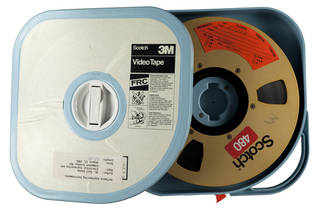
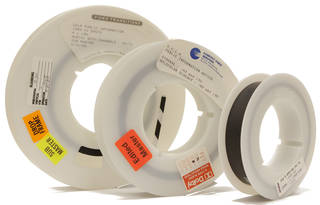
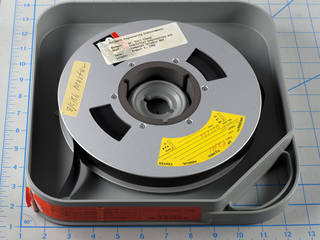

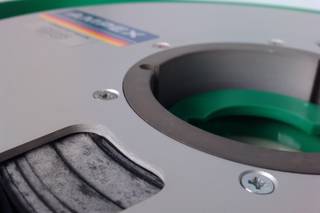
- Synonym
-
- 1" Type C
- Dates
- 1963 – mid 1990s
- Common Size(s)
- Tape width: 1"
- Description
- One-inch open reel is a magnetic tape-based analog video format, primarily used as a professional video format. The tape is composed of magnetic particles, a binder, and a polyester base. Common containers are made from plastic or sometimes cardboard; they are rectangular or have one curved side with a handle. The containers of open reels used for broadcast television typically have large labels with program titles, show air dates, record dates, and/or other information. One-inch open reels are easily identified by their distinctive wide hub. Audio recordings made on 1" tape may be mistaken for videotape.
- Composition
- Polyester magnetic tape on a plastic or metal reel
- Deterioration
- One-inch open reel is especially susceptible to risks associated with age, hardware, and equipment obsolescence. It is also prone to risks common to other types of magnetic media, such as mold, binder deterioration, physical damage, and signal drop-outs.
- Risk Level
- One-inch open reel tapes should be reformatted by a vendor with proven experience with this format. This format is especially vulnerable, and, based on content assessment, it should be a priority for reformatting.
- Playback
- One-inch open reels require format-specific equipment for playback. The media is obsolete and playback equipment in working order is exceptionally difficult to come by.
- Background
- One-inch open reel was introduced in 1963 by Philips' EL3400 helical scan recorder. It was used until approximately the mid 1990s, primarily for in-studio recordings. It was also used for preservation master tapes during the late 1980s and early 1990s.
- Storage Environment
-
Allowable Fluctuation: ±2°F; ±5% RH
Ideal Acceptable Temp. 40–54°F (4.5–12°C) 55–60°F (13–15.5°C) RH 30–50% RH - Storage Enclosure(s)
-
Acid-free enclosures are strongly advised. Each item should have its own enclosure to protect it from dust, handling damage, and changes in environmental conditions. All storage materials should pass the Photographic Activity Test (PAT) as specified in ISO Standard 18916:2007 and must be chemically and physically stable.
- Plastic: Polyethylene, polypropylene, or polyester (a.k.a. Mylar D or Melinex 516). No PVC or acetate.
- Paper/Paperboard: Neutral pH, lignin-free, buffered materials recommended.
The container should support the reel by the hub in order to preserve the tape pack and prevent distortion of the tape. Use unslotted reels if possible. Acid-free archival hold-down tape should be used to secure loose ends of the open reel tape.
Whenever feasible, replace original cardboard containers as they are typically non-archival (i.e. acidic) and have little or no hub support. When inspecting older open reel tape containers, be sure to check the inside of the container for debris. Open reel shipping containers often have a spongy lining that deteriorates over time into a powdery and then gummy substance that is very difficult to clean. This can cause damage to the surface of the tape. If you encounter this situation, place the tape (after thorough inspection) into a clean container. An enclosure must be truly clean in order to protect the fragile tape surface. Dust and dirt abrasions can affect playback quality and even render it unplayable. Moldy, damaged, and dirty containers must be replaced.
- Storage Orientation
-
Store all magnetic tape vertically on end, inside its case. Stacking any tape format horizontally--or even allowing it to lean for too long--can compromise a tape pack and cause warping. Its container should provide hub support for the reel in order to preserve the pack and prevent distortion.
Wood cabinets should be avoided. Enameled steel, stainless steel, or anodized aluminum are preferred.
- Handling/Care
- Never touch the surface of a magnetic tape recording. Handle by the hub instead. Do not pull on the tape or squeeze the reel flanges. This places stress on the tape, potentially causing distortion and damage. Never leave media in a playback machine; always return to storage enclosure when not in use.
½" Open Reel
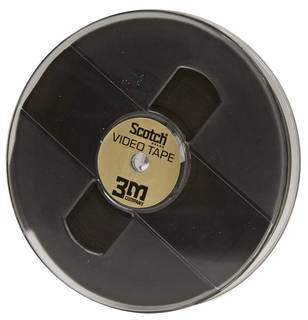
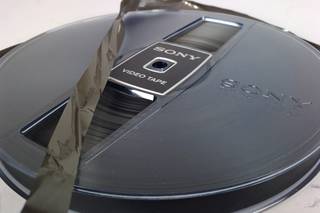
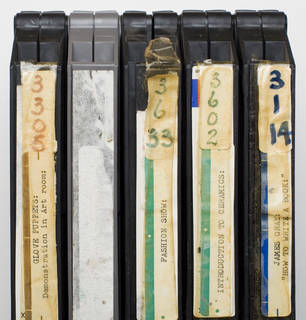
- Dates
- 1965 – late 1990s; most common, 1965 - c. 1980
- Common Size(s)
- Tape width: ½"
- Reel, small: 5" (diameter) / reel, large: 7¼" (diameter)
- Container, small: 5½" square × 1" / container, large: 8⅜" square × 1¼"
- Description
- Half-inch open reel is a magnetic tape-based analog video format, a professional format used in studios and for capturing footage in the field. The tape is composed of magnetic particles, a binder, and a polyester base. The most common containers for smaller tapes are approximately 5½" × 5½" × 1" in size and are made of a soft or hard plastic. Larger reels will be in containers approximately 8⅜" × 8⅜" × 1¼" in size. The plastic container may also be inside of a separate paperboard sleeve. There are other containers that are approximately the same size but have handles. Commonly used reels are 5" in diameter or 7¼" in diameter.
- Composition
- Polyester magnetic tape on a plastic or metal reel
- Deterioration
- Half-inch open reel is especially susceptible to risks associated with age, hardware, and equipment obsolescence. It is prone to risks common to other types of magnetic media like mold, binder deterioration, physical damage, and signal drop-outs. Half-inch open reel tapes are known to have problems with sticky shed syndrome.
- Risk Level
- Half-inch open reel tapes should be reformatted by a vendor with proven experience with this format. This format is especially vulnerable and, based on content assessment, should be prioritized for reformatting.
- Playback
- Half-inch open reels require format-specific equipment for playback. The media is obsolete, and playback equipment is exceptionally difficult to come by, especially in working order. There are two common ½" tape versions—CV and AV (EIAJ Type 1). They look the same, but will play back on different decks. CV tapes were manufactured beginning in 1965; AV was introduced in 1969. The tape reels are typically made from translucent plastic. The Sony tape containers are typically black and will be marked "For helical scan video recorders."
- Background
- Developed for the industrial, educational, and consumer markets, half-inch open reel was introduced in 1965 with Sony's CV-2000. It was used primarily for in-studio and field recording until approximately the late 1970s, when it was gradually replaced by cassette formats. It was also used as a format for preservation masters beginning in the late 1980s and early 1990s. Smaller reels were used in the first portable video recorders, or "portapaks," and larger reels were typically used for stationary recording and/or video editing.
- Storage Environment
-
Allowable Fluctuation: ±2°F; ±5% RH
Ideal Acceptable Temp. 40–54°F (4.5–12°C) 55–60°F (13–15.5°C) RH 30–50% RH - Storage Enclosure(s)
-
Acid-free enclosures are strongly advised. Each item should have its own enclosure to protect it from dust, handling damage, and changes in environmental conditions. All storage materials should pass the Photographic Activity Test (PAT) as specified in ISO Standard 18916:2007 and must be chemically and physically stable:
- Plastic: Polyethylene, polypropylene, or polyester (a.k.a. Mylar D or Melinex 516). No PVC or acetate.
- Paper/Paperboard: Neutral pH, lignin-free, buffered materials recommended.
The container should support the reel by the hub in order to preserve the tape pack and prevent distortion of the tape. Use unslotted reels if possible. Acid-free archival hold-down tape should be used to secure loose ends of the open reel tape.
Whenever feasible, replace original cardboard containers as they are typically non-archival (i.e. acidic) and have little or no hub support. An enclosure must be truly clean in order to protect the fragile tape surface. Dust and dirt abrasions can affect playback quality and even render it unplayable. Moldy, damaged, and dirty containers must be replaced.
- Storage Orientation
- Store all magnetic tape vertically on end, inside the case. Stacking any tape format horizontally--or even allowing it to lean for too long--can compromise a tape pack and cause warping. Its container should provide hub support for the reel in order to preserve the pack and prevent distortion. Wood cabinets should be avoided. Enameled steel, stainless steel, or anodized aluminum are preferred.
- Handling/Care
- Never touch the surface of a magnetic tape recording. Handle by the hub instead. Do not pull on the tape or squeeze the reel flanges. This places stress on the tape, potentially causing distortion and damage. Never leave media in a playback machine; always return to storage enclosure when not in use.
U-matic / U-matic SP
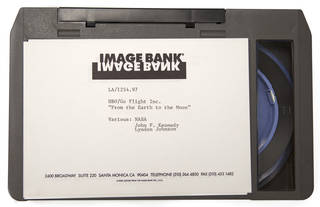

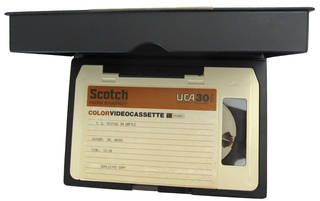
- Synonyms
-
- ¾" U-matic
- ¾" SP (U-matic SP)
- Dates
- U-matic: 1971 – c. 2000
- U-matic SP: 1986 – c. 2000
- Common Size(s)
- Tape width: ¾"
- Cassette, small: 7¼" × 4⅝" × 1⅕" / cassette, large: 8⅝" × 5⅜" × 1⅕"
- Description
- U-matic is a magnetic tape-based analog video cassette format. The tape is composed of magnetic particles, a binder, and a polyester base. Full-size cassettes are 8⅝" × 5⅜" × 1⅕" and can record up to 60 minutes of content; small cassettes are 7¼" × 4⅝" × 1⅕" and can hold up to 20 minutes of content. U-matic SP cassettes are brown and maroon, and they generally have "SP" printed on the side.
- Composition
- Polyester magnetic tape enclosed in a plastic cassette
- Deterioration
- Older tapes are susceptible to signal loss, while more recent tapes tend to fair a bit better. Tapes are also susceptible to damage from mold, binder deterioration, and other physical and biological issues. The biggest concern for the format, however, is media and hardware obsolescence.
- Risk Level
- Due to media and hardware obsolescence, this format should be considered at high preservation risk.
- Playback
- U-matic cassettes require format-specific equipment for playback. U-matic SP's picture quality is superior to the standard U-matic; the improvement in picture quality is lost, however, if the SP tapes are played back in a standard deck. Standard U-matic tapes cannot be played back on an SP deck at all.
- Background
- Standard U-matic was introduced in 1971; SP was introduced in 1986. The format was primarily developed for industrial and education markets. In the 1970s and 1980s, it was widely used for electronic news gathering; and, it was a preferred format for edit masters in the 1980s. It was also a primary format for many artists, community activists, academic institutions, and production houses up through the 1990s. As a result, many art and community videos are in this format.
- Storage Environment
-
Allowable Fluctuation: ±2°F; ±5% RH
Ideal Acceptable Temp. 40–54°F (4.5–12°C) 55–60°F (13–15.5°C) RH 30–50% RH - Storage Enclosure(s)
-
Acid-free enclosures are strongly advised. Each item should have its own enclosure to protect it from dust, handling damage, and changes in environmental conditions. All storage materials should pass the Photographic Activity Test (PAT) as specified in ISO Standard 18916:2007 and must be chemically and physically stable:
- Plastic: Polyethylene, polypropylene, or polyester (a.k.a. Mylar D or Melinex 516). No PVC or acetate.
- Paper/Paperboard: Neutral pH, lignin-free, buffered materials recommended.
Inert plastic containers are ideal. If housed in a plastic container and you are unsure if it is acceptable, check the condition of the container. The container is acceptable if it is protecting the media from dust, pests, and other contaminants; is not shedding or introducing any contaminants through its own degradation; and, is clean and free of mold or excessive dirt. Anything other (e.g. a cardboard or thin plastic slipcover) than a hard plastic container means that it is not sufficiently protected and that it should be rehoused in a clean, inert hard plastic container.
An enclosure must be truly clean in order to protect the fragile tape surface. Dust and dirt abrasions can affect sound quality and even render the tape unplayable. Moldy, damaged, and dirty containers must be replaced.
- Storage Orientation
- The best orientation for a cassette is vertical on its end. Cassettes and cartridges, generally speaking, like to be stored upright on shelves like books. Piling tapes one upon the other tends to stress the cassettes at bottom; and over time, this can cause the plastic housing to warp and even crack. Allowing cassettes to lean for too long in a suboptimal environment can also lead to distortion. Wood cabinets should be avoided. Enameled steel, stainless steel, or anodized aluminum are preferred.
- Handling/Care
- Engage the record protection mechanism if it has not already been done. Do not attempt to open a tape cassette/cartridge--this is likely to cause greater damage unless you know what you are doing. Furthermore, never touch the magnetic tape surface. Keep magnetic media away from stray electromagnetic fields and avoid devices with a motor or transformer, both of which generate an alternating magnetic field. Never leave media in a playback machine; always return to storage enclosure when not in use. For more information about protection mechanisms, see Playback.
Betamax
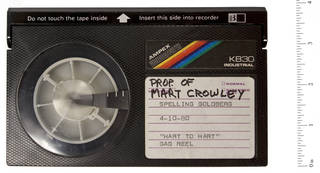
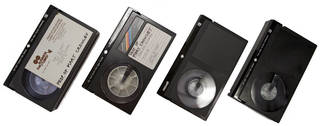
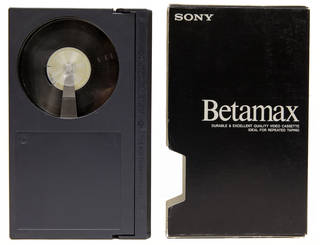
- Synonym
-
- Beta (ambiguation)
- Dates
- 1975 – late 1980s
- Common Size(s)
- Tape width: ½"
- Cassette: 6⅛" × 3¾" × 1"
- Description
- Betamax is a magnetic tape-based analog video cassette format. It was a capture format and a commercial release video format. The tape is composed of magnetic particles, a binder, and a polyester base. Cassette dimensions are: 6⅛" × 3¾" × 1" with a tape width of ½".
- Composition
- Polyester magnetic tape enclosed in a plastic cassette
- Deterioration
- Betamax tapes are susceptible to signal loss due to their age. Tapes are also susceptible to damage from mold, binder deterioration, and other physical and biological issues.
- Risk Level
- Betamax tapes are at high risk due to media and equipment obsolescence.
- Playback
- Betamax cassettes require format-specific equipment for playback. Betamax tapes are played back using Betamax VCRs. However, depending on the speed that the tape was recorded at, some Betamax tapes may not readable by all Betamax VCRs.
- Background
- Betamax was introduced in 1975 and was in use until the late 1980s. It was a relatively short-lived format that ultimately lost the format war to VHS. It was developed for the consumer, industrial, and educational markets. Although it did not gain widespread consumer popularity, this format was considered to be technically superior to VHS. It was used extensively in schools, in community media centers, and by artists.
- Storage Environment
-
Allowable Fluctuation: ±2°F; ±5% RH
Ideal Acceptable Temp. 40–54°F (4.5–12°C) 55–60°F (13–15.5°C) RH 30–50% RH - Storage Enclosure(s)
-
Acid-free enclosures are strongly advised. Each item should have its own enclosure to protect it from dust, handling damage, and changes in environmental conditions. All storage materials should pass the Photographic Activity Test (PAT) as specified in ISO Standard 18916:2007 and must be chemically and physically stable:
- Plastic: Polyethylene, polypropylene, or polyester (a.k.a. Mylar D or Melinex 516). No PVC or acetate.
- Paper/Paperboard: Neutral pH, lignin-free, buffered materials recommended.
Inert plastic containers are ideal. If housed in a plastic container and you are unsure if it is acceptable, check the condition of the container. The container is acceptable if it is protecting the media from dust, pests, and other contaminants; is not shedding or introducing any contaminants through its own degradation; and, is clean and free of mold or excessive dirt. Anything other (e.g. a cardboard or thin plastic slipcover) than a hard plastic container means that it is not sufficiently protected and that it should be rehoused in a clean, inert hard plastic container.
An enclosure must be truly clean in order to protect the fragile tape surface. Dust and dirt abrasions can affect sound quality and even render the tape unplayable. Moldy, damaged, and dirty containers must be replaced.
- Storage Orientation
- The best orientation for a cassette is vertical on its end. Cassettes and cartridges, generally speaking, like to be stored upright on shelves like books. Piling tapes one upon the other tends to stress the cassettes at bottom; and over time, this can cause the plastic housing to warp and even crack. Allowing cassettes to lean for too long in a suboptimal environment can also lead to distortion. Wood cabinets should be avoided. Enameled steel, stainless steel, or anodized aluminum are preferred.
- Handling/Care
- Engage the record protection mechanism if it has not already been done. Do not attempt to open a tape cassette/cartridge; this is likely to cause greater damage unless you know what you are doing. Furthermore, never touch the magnetic tape surface. Keep magnetic media away from stray electromagnetic fields; avoid devices with a motor or transformer, both of which generate an alternating magnetic field. Never leave media in a playback machine; always return to storage enclosure when not in use. For more information about protection mechanisms, see Playback.
VHS

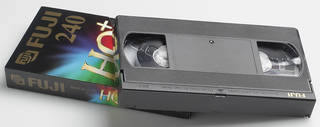
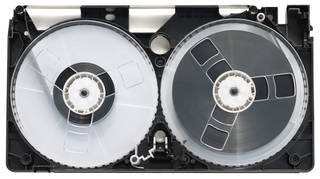
- Synonyms
-
- Videocassette
- S-VHS
- Dates
- VHS: 1976 – present; less common after c. 2000
- S-VHS: 1987 - late 1990s
- Common Size(s)
- Tape width: ½" (12.7mm)
- Cassette: 187mm × 103mm × 25mm
- Description
- VHS is a magnetic tape-based analog video cassette format. The tape is composed of magnetic particles, a binder, and a polyester base. Cassette dimensions are: 187mm wide, 103mm deep, 25mm thick, with a tape width of ½" (12.7mm) for both VHS and S-VHS. A VHS (or S-VHS) logo is usually imprinted on the cassette in the upper right-hand corner, while the manufacturer's name is imprinted in the upper left. S-VHS tapes have an additional hole on the back of the cassette.
- Composition
- Polyester magnetic tape enclosed in a plastic cassette
- Deterioration
- Older VHS tapes are susceptible to signal loss due to age. Tapes are also susceptible to damage from mold, binder deterioration, and other physical and biological issues.
- Risk Level
- This format is considered at low preservation risk as the media and equipment are still currently available.
- Playback
- VHS tapes require format-specific VCRs for playback. S-VHS has a superior picture quality compared to VHS and is "upwardly compatible." This means that S-VHS tapes are playable in VHS decks but VHS tapes are not playable in S-VHS decks. The VHS format is currently still supported. VCRs to play VHS tapes are still easily available, largely due to the format's long period of ubiquity prior to the introduction of consumer digital video.
- Background
- VHS was introduced in 1976, and S-VHS was introduced in 1987. Although less common, VHS is still in use. S-VHS was largely replaced by digital video by the late 1990s.
- Storage Environment
-
Allowable Fluctuation: ±2°F; ±5% RH
Ideal Acceptable Temp. 40–54°F (4.5–12°C) 55–60°F (13–15.5°C) RH 30–50% RH - Storage Enclosure(s)
-
Acid-free enclosures are strongly advised. Each item should have its own enclosure to protect it from dust, handling damage, and changes in environmental conditions. All storage materials should pass the Photographic Activity Test (PAT) as specified in ISO Standard 18916:2007 and must be chemically and physically stable:
- Plastic: Polyethylene, polypropylene, or polyester (a.k.a. Mylar D or Melinex 516). No PVC or acetate.
- Paper/Paperboard: Neutral pH, lignin-free, buffered materials recommended.
Inert plastic containers are ideal. If housed in a plastic container and you are unsure if it is acceptable, check the condition of the container. The container is acceptable if it is protecting the media from dust, pests, and other contaminants; is not shedding or introducing any contaminants through its own degradation; and, is clean and free of mold or excessive dirt. Anything other than a hard plastic container (e.g. a cardboard or thin plastic slipcover) that means it is not sufficiently protected and that it should be rehoused in a clean, inert plastic container.
An enclosure must be truly clean in order to protect the fragile tape surface. Dust and dirt abrasions can affect sound quality and even render the tape unplayable. Moldy, damaged, and dirty containers must be replaced.
- Storage Orientation
- The best orientation for a cassette is vertical on its end. Cassettes and cartridges, generally speaking, like to be stored upright on shelves like books. Piling tapes one upon the other tends to stress the cassettes at bottom; and over time, this can cause the plastic housing to warp and even crack. Allowing cassettes to lean for too long in a suboptimal environment can also lead to distortion. Wood cabinets should be avoided. Enameled steel, stainless steel, or anodized aluminum are preferred.
- Handling/Care
- Engage the record protection mechanism if it has not already been done. Do not attempt to open a tape cassette/cartridge; this is likely to cause greater damage unless you know what you are doing. Furthermore, never touch the magnetic tape surface. Keep magnetic media away from stray electromagnetic fields; avoid devices with a motor or transformer, both of which generate an alternating magnetic field. Never leave media in a playback machine; always return to storage enclosure when not in use. For more information about protection mechanisms, see Playback.
Betacam / Betacam SP
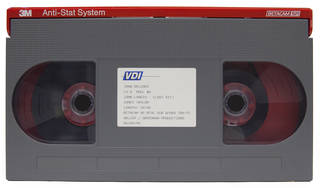
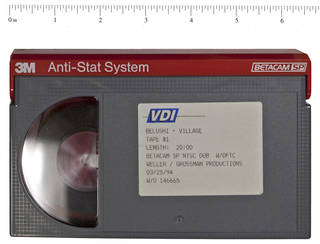
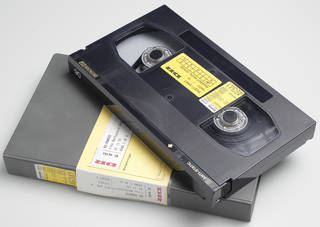
- Synonym
-
- Beta (ambiguation)
- Dates
- Betacam: 1982 – present
- Betacam SP: 1986 – present
- Common Size(s)
- Tape width: ½"
- Cassette case, small: 6¾" × 4⅜" × 1⅕" / cassette case, large: 10⅝" × 6⅜" × 1¼"
- Description
- Betacam is a magnetic tape-based analog video cassette format. The tape is composed of magnetic particles, a binder, and a polyester base. Large cassette cases are 10⅝" × 6⅜" × 1¼", and small cassette cases are 6¾" × 4⅜" × 1⅕". Tape cassettes are generally labeled as "Betacam" or "Betacam SP" in the upper right-hand corner.
- Composition
- Polyester magnetic tape enclosed in a plastic cassette
- Deterioration
- Older Betacam tapes are susceptible to signal loss due to age. Tapes are also susceptible to damage from mold, binder deterioration, and other physical and biological issues.
- Risk Level
- Equipment obsolescence is not yet a concern, since both Betacam SX and Digital Betacam decks are still in production and can play back a variety of Beta cassettes. Betacam cassettes tend to be durable, so most of the format's risk is determined by its age. This format would currently be considered low risk.
- Playback
- Betacam cassettes require format-specific equipment for playback. Betacam SP has technical advantages over Betacam because it is "upwardly compatible." This means that Betacam tapes are playable on Betacam SP decks, but tapes recorded in Betacam SP are not playable on Betacam decks. While decks for Betacam and Betacam SP are no longer in production, most newer decks in the Betacam family, such as Digital Betacam and Betacam SX decks, will play Betacam and Betacam SP tapes.
- Background
- Betacam was introduced in 1982, and Betacam SP was introduced in 1986.
- Storage Environment
-
Allowable Fluctuation: ±2°F; ±5% RH
Ideal Acceptable Temp. 40–54°F (4.5–12°C) 55–60°F (13–15.5°C) RH 30–50% RH - Storage Enclosure(s)
-
Acid-free enclosures are strongly advised. Each item should have its own enclosure to protect it from dust, handling damage, and changes in environmental conditions. All storage materials should pass the Photographic Activity Test (PAT) as specified in ISO Standard 18916:2007 and must be chemically and physically stable.
- Plastic: Polyethylene, polypropylene, or polyester (a.k.a. Mylar D or Melinex 516). No PVC or acetate.
- Paper/Paperboard: Neutral pH, lignin-free, buffered materials recommended.
Inert plastic containers are ideal. If housed in a plastic container and you are unsure if it is acceptable, check the condition of the container. The container is acceptable if it is protecting the media from dust, pests, and other contaminants; is not shedding or introducing any contaminants through its own degradation; and, is clean and free of mold or excessive dirt. Anything other (e.g. a cardboard or thin plastic slipcover) than a hard plastic container means that it is not sufficiently protected and that it should be rehoused in a clean, inert hard plastic container.
An enclosure must be truly clean in order to protect the fragile tape surface. Dust and dirt abrasions can affect sound quality and even render the tape unplayable. Moldy, damaged, and dirty containers must be replaced.
- Storage Orientation
- The best orientation for a cassette is vertical on its end. Cassettes and cartridges, generally speaking, like to be stored upright on shelves like books. Piling tapes one upon the other tends to stress the cassettes at bottom; and over time, this can cause the plastic housing to warp and even crack. Allowing cassettes to lean for too long in a suboptimal environment can also lead to distortion. Wood cabinets should be avoided. Enameled steel, stainless steel, or anodized aluminum are preferred.
- Handling/Care
- Engage the record protection mechanism if it has not already been done. Do not attempt to open a tape cassette/cartridge; this is likely to cause greater damage unless you know what you are doing. Furthermore, never touch the magnetic tape surface. Keep magnetic media away from stray electromagnetic fields and avoid devices with a motor or transformer, both of which generate an alternating magnetic field. Never leave media in a playback machine; always return to storage enclosure when not in use. For more information about protection mechanisms, see Playback.
Video8 / Hi8
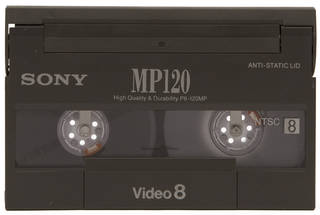
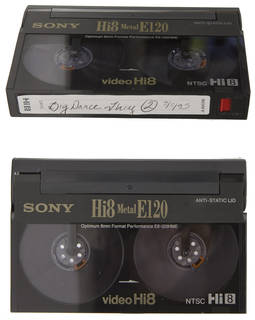
- Synonym
-
- 8mm video
- Dates
- Video8: 1984 – late 2000s
- Hi8: 1989 – 2007
- Common Size(s)
- Tape width: 8mm
- Cassette: 3⅔" × 2⅜" × ½"
- Description
- Video8 and Hi8 are magnetic tape-based analog video cassette formats, which were chiefly used in the consumer home video market of the 1980s and 1990s. The tape is composed of magnetic particles, a binder, and a polyester base. The dimensions for both Video8 and Hi8 are 3⅔" × 2⅜" × ½". Tapes are usually labeled as Hi8mm or 8mm (for Video8) between the two reels on the bottom center of the cassette.
- Composition
- Polyester magnetic tape enclosed in a plastic cassette
- Deterioration
- Both Video8 and Hi8 tapes are prone to stretching. The longer the tape (i.e. longer than 60 minutes), the more susceptible it is to damage. Hi8 metal evaporated (ME) tapes are especially likely to have durability problems.
- Risk Level
- Digital formats are replacing the analog Video8 and Hi8, so obsolescence is a risk in the near future. Although Video8 and Hi8 are relatively new formats, they are especially fragile and are not recommended for long-term storage. Hi8 ME tapes are especially prone to durability problems. Depending on the intellectual content, it is recommended that these formats receive reformatting priority.
- Playback
- Hi8 has technical advantages over Video8 and is "upwardly compatible." This means that Hi8 tapes are playable on Video8 decks, but tapes recorded in Video8 are not playable on Hi8 decks. Decks for both formats are no longer being produced and are increasingly rare. Video8 and Hi8 tapes generally require format-specific decks for playback but can possibly be played using some Digital8 players. Due to their size, Video8 and Hi8 decks are not as durable as their larger format counterparts, and they are difficult and expensive to repair. These factors could affect future availability of playback equipment.
- Background
- Video8 was introduced in 1984 by Sony, and Hi8 came soon after in 1989. Video8 was developed for the consumer market, whereas Hi8 was geared toward consumer, industrial, and educational markets. Replaced by Digital8 in 1999, Hi8 camcorders were commercially available until 2007, the same year that Digital8 camcorders and decks were also discontinued.
- Storage Environment
-
Allowable Fluctuation: ±2°F; ±5% RH
Ideal Acceptable Temp. 40–54°F (4.5–12°C) 55–60°F (13–15.5°C) RH 30–50% RH - Storage Enclosure(s)
-
Acid-free enclosures are strongly advised. Each item should have its own enclosure to protect it from dust, handling damage, and changes in environmental conditions. All storage materials should pass the Photographic Activity Test (PAT) as specified in ISO Standard 18916:2007 and must be chemically and physically stable:
- Plastic: Polyethylene, polypropylene, or polyester (a.k.a. Mylar D or Melinex 516). No PVC or acetate.
- Paper/Paperboard: Neutral pH, lignin-free, buffered materials recommended.
Inert plastic containers are ideal. If housed in a plastic container and you are unsure if it is acceptable, check the condition of the container. The container is acceptable if it is protecting the media from dust, pests, and other contaminants; is not shedding or introducing any contaminants through its own degradation; and, is clean and free of mold or excessive dirt. Anything other than a hard plastic container, e.g. a cardboard or thin plastic slipcover, or is not sufficiently protected, it should be rehoused in a clean, inert plastic container.
An enclosure must be truly clean in order to protect the fragile tape surface. Dust and dirt abrasions can affect sound quality and even render the tape unplayable. Moldy, damaged, and dirty containers must be replaced.
- Storage Orientation
- The best orientation for a cassette is vertical on its end. Cassettes and cartridges, generally speaking, like to be stored upright on shelves like books. Piling tapes one upon the other tends to stress the cassettes at bottom; and over time, this can cause the plastic housing to warp and even crack. Allowing cassettes to lean for too long in a suboptimal environment can also lead to distortion. Wood cabinets should be avoided. Enameled steel, stainless steel, or anodized aluminum are preferred.
- Handling/Care
- Engage the record protection mechanism if it has not already been done. Do not attempt to open a tape cassette or cartridge; this is likely to cause greater damage unless you know what you are doing. Furthermore, never touch the magnetic tape surface. Keep magnetic media away from stray electromagnetic fields; avoid devices with a motor or transformer, both of which generate an alternating magnetic field. Never leave media in a playback machine; always return to storage enclosure when not in use. For more information about protection mechanisms, see Playback.
D-2
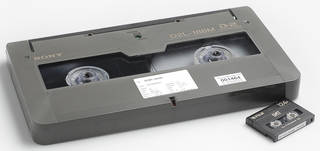
- Dates
- 1988 – 2000s
- Common Size(s)
- Tape width: ¾"
- Cassette, small: 6¾" × 4¼" × 1⅓" / cassette, medium: 10" × 5⅞" × 1⅓"
- Description
- D-2 is a magnetic tape-based digital video cassette format. The tape is composed of magnetic particles, a binder, and a polyester base. Medium cassettes are 10" × 5⅞" × 1⅓" and small cassettes are 6¾" × 4¼" × 1⅓" with a tape width of ¾". The cassettes are usually gray with tape identification in the upper right-hand corner.
- Composition
- Polyester magnetic tape enclosed in a plastic cassette
- Deterioration
- Physically, D-2 is subject to the same concerns as analog tapes—stretching, breaking, drop-outs, mold, binder deterioration, and unintended recording.
- Risk Level
- As with most magnetic media, D-2 is subject to the threat of obsolescence. It is uncertain how long D-2 will remain on the market considering the "format wars" among digital tape and playback equipment manufacturers.
- Playback
- D-2 cassettes require format-specific equipment for playback.
- Background
- D-2 was introduced in 1988 by Ampex and Sony. It is presently still in use in some production communities, although its use has dropped off considerably since the introduction of high-definition video. D-2 was introduced as the affordable uncompressed (composite) digital video counterpart to the notoriously costly D-1. It was one of the first digital formats used for high-end production. For this reason, it has been used as a mastering format in television, advertising, and corporate sectors.
- Storage Environment
-
Allowable Fluctuation: ±2°F; ±5% RH
Ideal Acceptable Temp. 40–54°F (4.5–12°C) 55–60°F (13–15.5°C) RH 30–50% RH - Storage Enclosure(s)
-
Acid-free enclosures are strongly advised. Each item should have its own enclosure to protect it from dust, handling damage, and changes in environmental conditions. All storage materials should pass the Photographic Activity Test (PAT) as specified in ISO Standard 18916:2007 and must be chemically and physically stable:
- Plastic: Polyethylene, polypropylene, or polyester (a.k.a. Mylar D or Melinex 516). No PVC or acetate.
- Paper/Paperboard: Neutral pH, lignin-free, buffered materials recommended.
Inert plastic containers are ideal. If housed in a plastic container and you are unsure if it is acceptable, check the condition of the container. The container is acceptable if it is protecting the media from dust, pests, and other contaminants; is not shedding or introducing any contaminants through its own degradation; and, is clean and free of mold or excessive dirt. Anything other (e.g. a cardboard or thin plastic slipcover) than a hard plastic container means that it is not sufficiently protected and that it should be rehoused in a clean, inert hard plastic container.
An enclosure must be truly clean in order to protect the fragile tape surface. Dust and dirt abrasions can affect sound quality and even render the tape unplayable. Moldy, damaged, and dirty containers must be replaced.
- Storage Orientation
- The best orientation for a cassette is vertical on its end. Cassettes and cartridges, generally speaking, like to be stored upright on shelves like books. Piling tapes one upon the other tends to stress the cassettes at bottom; and over time, this can cause the plastic housing to warp and even crack. Allowing cassettes to lean for too long in a suboptimal environment can also lead to distortion. Wood cabinets should be avoided. Enameled steel, stainless steel, or anodized aluminum are preferred.
- Handling/Care
- Engage the record protection mechanism if it has not already been done. Do not attempt to open a tape cassette/cartridge; this is likely to cause greater damage unless you know what you are doing. Furthermore, never touch the magnetic tape surface. Keep magnetic media away from stray electromagnetic fields; avoid devices with a motor or transformer, both of which generate an alternating magnetic field. Never leave media in a playback machine; always return to storage enclosure when not in use. For more information about protection mechanisms, see Playback.
D-3
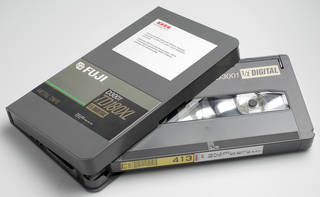
- Dates
- 1991 – present
- Common Size(s)
- Tape width: ½"
- Cassette: 8¼" × 4⅞" × 1"
- Description
- D-3 is a magnetic tape-based digital video cassette format. The tape is composed of magnetic particles, a binder, and a polyester base. Cassettes are 8¼" × 4⅞" × 1" with a tape width of ½". D-3 has a longer tape time and less cost per tape compared to D-2. The cassettes are usually gray with tape identification in the upper right-hand corner.
- Composition
- Polyester magnetic tape enclosed in a plastic cassette
- Deterioration
- Physically, D-3 is subject to the same concerns as analog tapes—stretching, breaking, drop-outs, mold, binder deterioration, and unintended recording. It is uncertain how long D-3 will remain on the market considering the "format wars" among digital tape and playback equipment manufacturers.
- Risk Level
- As with most magnetic media, D-3 is subject to the threat of obsolescence. It is difficult to determine how long this format will continue to be supported, and it is therefore not recommended as an archival format. Considering its age and comparative durability, reformatting is not an immediate preservation priority unless there are obvious signs of tape failure.
- Playback
- D-3 cassettes require format-specific equipment for playback.
- Background
- D-3 was commercially introduced in 1991 by Panasonic. It is presently still in use in some production communities, although its use has dropped off considerably since the introduction of high-definition video. D-3 was developed for high-end production and marketed as the affordable uncompressed (composite) digital video competition to Ampex's D-2. The D-3 has been used as a mastering format in television, advertising, and corporate sectors.
- Storage Environment
-
Allowable Fluctuation: ±2°F; ±5% RH
Ideal Acceptable Temp. 40–54°F (4.5–12°C) 55–60°F (13–15.5°C) RH 30–50% RH - Storage Enclosure(s)
-
Acid-free enclosures are strongly advised. Each item should have its own enclosure to protect it from dust, handling damage, and changes in environmental conditions. All storage materials should pass the Photographic Activity Test (PAT) as specified in ISO Standard 18916:2007 and must be chemically and physically stable:
- Plastic: Polyethylene, polypropylene, or polyester (a.k.a. Mylar D or Melinex 516). No PVC or acetate.
- Paper/Paperboard: Neutral pH, lignin-free, buffered materials recommended.
Inert plastic containers are ideal. If housed in a plastic container and you are unsure if it is acceptable, check the condition of the container. The container is acceptable if it is protecting the media from dust, pests, and other contaminants; is not shedding or introducing any contaminants through its own degradation; and, is clean and free of mold or excessive dirt. Anything other (e.g. a cardboard or thin plastic slipcover) than a hard plastic container means that it is not sufficiently protected and that it should be rehoused in a clean, inert hard plastic container.
An enclosure must be truly clean in order to protect the fragile tape surface. Dust and dirt abrasions can affect sound quality and even render the tape unplayable. Moldy, damaged, and dirty containers must be replaced.
- Storage Orientation
- The best orientation for a cassette is vertical on its end. Cassettes and cartridges, generally speaking, like to be stored upright on shelves like books. Piling tapes one upon the other tends to stress the cassettes at bottom; and over time, this can cause the plastic housing to warp and even crack. Allowing cassettes to lean for too long in a suboptimal environment can also lead to distortion. Wood cabinets should be avoided. Enameled steel, stainless steel, or anodized aluminum are preferred.
- Handling/Care
- Engage the record protection mechanism if it has not already been done. Do not attempt to open a tape cassette/cartridge; this is likely to cause greater damage unless you know what you are doing. Furthermore, never touch the magnetic tape surface. Keep magnetic media away from stray electromagnetic fields; avoid devices with a motor or transformer, both of which generate an alternating magnetic field. Never leave media in a playback machine; always return to storage enclosure when not in use. For more information about protection mechanisms, see Playback.
Digital Betacam
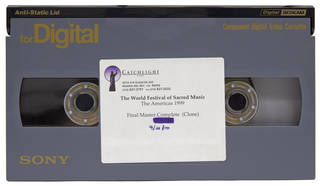
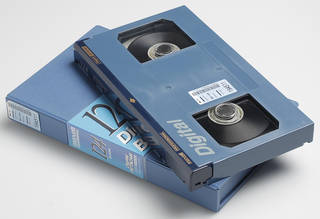
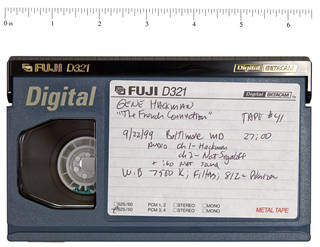
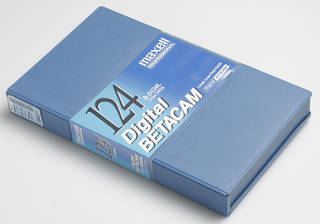
- Synonyms
-
- DigiBeta
- D-Beta
- Dates
- 1993 – present
- Common Size(s)
- Tape width: ½"
- Cassette, small: 6⅛" × 3¾" × 1" / cassette, large: 9⅓" × 5⅔" × 1"
- Description
- Digital Betacam is a magnetic tape-based digital video cassette format. The cassettes are usually a light grayish blue in color with "Digital Betacam" printed on the upper right-hand corner and "for Digital" in the upper left-hand corner. The tape is composed of magnetic particles, a binder, and a polyester base. Small cassettes measure 6⅛" × 3¾" × 1" and are used in cameras; and, they have an available recording length of 40 minutes. Large cassettes are 9⅓" × 5⅔" × 1" and are used in recording and editing decks; and, they have an available recording length of about 124 minutes. Digital Betacam records component video with five audio channels.
- Composition
- Polyester magnetic tape enclosed in a plastic cassette
- Deterioration
- Digital Betacam is subject to the same physical issues as analog tapes—stretching, breaking, drop-outs, mold, binder deterioration, and unintended recording.
- Risk Level
- Presently, market share and the production of backward-compatible playback decks seem to suggest a lesser threat to obsolescence compared to other formats. However as with any newer video format, it is difficult to predict how long it will be supported. Digital Betacam is often considered the best choice for preservation masters because it is regarded as mitigating risks rather than being subject to them.
- Playback
- Digital Betacam cassettes require format-specific equipment for playback. Some Digital Betacam players are backwards-compatible with earlier Betacam formats.
- Background
- Digital Betacam, which was developed for the professional market, was introduced in 1993 as the digital successor of Betacam SP. Although it is still in use, particularly in industrial and professional sectors, it never reached the industry support of its predecessor. For some time, Digital Betacam was used for video preservation masters in broadcast archives.
- Storage Environment
-
Allowable Fluctuation: ±2°F; ±5% RH
Ideal Acceptable Temp. 40–54°F (4.5–12°C) 55–60°F (13–15.5°C) RH 30–50% RH - Storage Enclosure(s)
-
Acid-free enclosures are strongly advised. Each item should have its own enclosure to protect it from dust, handling damage, and changes in environmental conditions. All storage materials should pass the Photographic Activity Test (PAT) as specified in ISO Standard 18916:2007 and must be chemically and physically stable:
- Plastic: Polyethylene, polypropylene, or polyester (a.k.a. Mylar D or Melinex 516). No PVC or acetate.
- Paper/Paperboard: Neutral pH, lignin-free, buffered materials recommended.
Inert plastic containers are ideal. If housed in a plastic container and you are unsure if it is acceptable, check the condition of the container. The container is acceptable if it is protecting the media from dust, pests, and other contaminants; is not shedding or introducing any contaminants through its own degradation; and, is clean and free of mold or excessive dirt. Anything other (e.g. a cardboard or thin plastic slipcover) than a hard plastic container means that it is not sufficiently protected and that it should be rehoused in a clean, inert hard plastic container.
An enclosure must be truly clean in order to protect the fragile tape surface. Dust and dirt abrasions can affect sound quality and even render the tape unplayable. Moldy, damaged, and dirty containers must be replaced.
- Storage Orientation
- The best orientation for a cassette is vertical on its end. Cassettes and cartridges, generally speaking, like to be stored upright on shelves like books. Piling tapes one upon the other tends to stress the cassettes at bottom; and over time, this can cause the plastic housing to warp and even crack. Allowing cassettes to lean for too long in a suboptimal environment can also lead to distortion. Wood cabinets should be avoided. Enameled steel, stainless steel, or anodized aluminum are preferred.
- Handling/Care
- Engage the record protection mechanism if it has not already been done. Do not attempt to open a tape cassette/cartridge; this is likely to cause greater damage unless you know what you are doing. Furthermore, never touch the magnetic tape surface. Keep magnetic media away from stray electromagnetic fields; avoid devices with a motor or transformer, all of which generate an alternating magnetic field. Never leave media in a playback machine; always return to storage enclosure when not in use. For more information about protection mechanisms, see Playback.
MiniDV

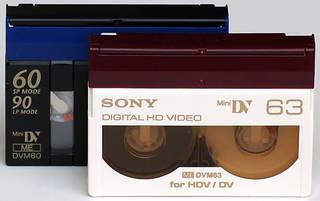
- Synonyms
-
- DV (Digital Video)
- DVC
- Dates
- 1995 – late 2000s
- Common Size(s)
- Tape width: ¼"
- Cassette: 2½" × 1⅞" × ⅖"
- Description
- MiniDV is a magnetic tape-based digital video (DV) cassette format. It was used chiefly for consumer home video in the late 1990s and early 2000s. The tape is composed of magnetic particles, a binder, and a polyester base. Cassette dimensions are: 2½" × 1⅞" × ⅖" with a tape width of ¼". Cassettes are generally labeled either in the lower left-hand corner (Sony) or on a sticker on the right-hand side (Panasonic). All MiniDV designations for Panasonic tapes are indicated by stickers or the packaging, and they may be covered with labels that list title or production information.
- Composition
- Polyester magnetic tape enclosed in a plastic cassette.
- Deterioration
- MiniDV is subject to the same physical issues as analog tapes—stretching, breaking, drop-outs, mold, binder deterioration, and unintended recording. The size and durability of MiniDV, as with any small, thin tape, is a concern. It has similar issues as Hi8.
- Risk Level
- Presently, market share seems to suggest a lessened threat of obsolescence. However, as with any newer video format, it is difficult to predict how long it will be supported. Due to its size and the thinness of its tape, MiniDV is not an archival format. MiniDVs also require proprietary tape. These cassettes should be given reformatting priority based on their content value.
- Playback
- MiniDV cassettes require format-specific camcorders for playback.
- Background
- MiniDV was introduced in 1995 and was commonly in use until the late 2000s. This format was originally called DV, but it is now commonly known as MiniDV. It was developed for consumer, industrial, and educational markets. MiniDV was used extensively by artists and community activists, both in the educational sector and in independent production. Its small size and high visual quality made it popular for field acquisition (e.g. camera recording).
- Storage Environment
-
Allowable Fluctuation: ±2°F; ±5% RH
Ideal Acceptable Temp. 40–54°F (4.5–12°C) 55–60°F (13–15.5°C) RH 30–50% RH - Storage Enclosure(s)
-
Acid-free enclosures are strongly advised. Each item should have its own enclosure to protect it from dust, handling damage, and changes in environmental conditions. All storage materials should pass the Photographic Activity Test (PAT) as specified in ISO Standard 18916:2007 and must be chemically and physically stable:
- Plastic: Polyethylene, polypropylene, or polyester (a.k.a. Mylar D or Melinex 516). No PVC or acetate.
- Paper/Paperboard: Neutral pH, lignin-free, buffered materials recommended.
Inert plastic containers are ideal. If housed in a plastic container and you are unsure if it is acceptable, check the condition of the container. The container is acceptable if it is protecting the media from dust, pests, and other contaminants; is not shedding or introducing any contaminants through its own degradation; and, is clean and free of mold or excessive dirt. Anything other (e.g. a cardboard or thin plastic slipcover) than a hard plastic container means that it is not sufficiently protected and that it should be rehoused in a clean, inert plastic container.
An enclosure must be truly clean in order to protect the fragile tape surface. Dust and dirt abrasions can affect sound quality and even render the tape unplayable. Moldy, damaged, and dirty containers must be replaced.
- Storage Orientation
-
The best orientation for a cassette is vertical on its end. Cassettes and cartridges, generally speaking, like to be stored upright on shelves like books. Piling tapes on top of each other tends to stress the cassettes at bottom; and over time, this can cause the plastic housing to warp and even crack. Allowing cassettes to lean for too long in a suboptimal environment can also lead to distortion.
Wood cabinets should be avoided. Enameled steel, stainless steel, or anodized aluminum are preferred.
- Handling/Care
- Engage the record protection mechanism if it has not already been done. Do not attempt to open a tape cassette/cartridge; this is likely to cause greater damage unless you know what you are doing. Furthermore, never touch the magnetic tape surface. Keep magnetic media away from stray electromagnetic fields; avoid devices with a motor or transformer, both of which generate an alternating magnetic field. Never leave media in a playback machine; always return to storage enclosure when not in use. For more information about protection mechanisms, see Playback.
DVCPRO
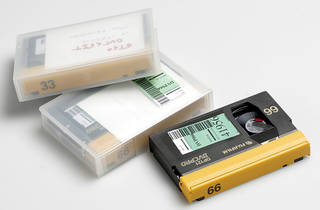
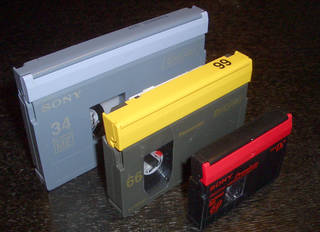
- Synonyms
-
- D7
- DVCPRO25
- Digital Video (ambiguation)
- Dates
- 1995 – present
- Common Size(s)
- Tape width: ¼"
- Cassette, medium: 3⅘" × 2 ½" × ½" / cassette, large: 4⅞" × 3" × ½"
- Description
- DVCPro is a magnetic tape-based digital video (DV) cassette format. The tape is composed of magnetic particles, a binder, and a polyester base. Large cassettes measure 4⅞" × 3" × ½", are for use in recording and editing decks, and have an available recording length of about 126 minutes. Medium cassettes measure 3⅘" × 2½" × ½", are for use in cameras, and have an available recording length of up to 66 minutes. Cassettes are generally dark gray in color with a yellow anti-static cover (Panasonic), black with a yellow anti-static cover (Maxell), or black with a red anti-static cover (Fuji). The DVCPro logo is usually in the upper right-hand corner, and the tape length is generally listed on the left-hand corner. Panasonic cassettes also designate large cassettes with the letter "L" after the tape length (i.e. 126L).
- Composition
- Polyester magnetic tape enclosed in a plastic cassette
- Deterioration
- DVCPro is subject to the same physical issues as analog tapes—stretching, breaking, drop-outs, mold, binder deterioration, and unintended recording.
- Risk Level
- Given ongoing media "format wars," the future of DVCPro is unknown. As with most magnetic media, DVCPro is subject to the threat of obsolescence. Although DVCPro is not an archival format, reformatting is not an immediate preservation priority unless there are obvious signs of tape failure.
- Playback
- DVCPro cassettes require format-specific equipment for playback. While the DVCPro format uses the same tape width and compression rate as DVCam, the cassette housing is different and it is not fully compatible with other digital video (DV) products. DVCPro decks will play MiniDV and DVCam tapes, but few DVCam decks will play DVCPro tapes.
- Background
- DVCPro was introduced in 1995 and is presently still in use. The DVCPro format was developed by Panasonic for industrial, educational, and professional markets. It is used for electronic news gathering, cable television, and other field production, including independent production. One of the first small digital formats, it was initially popular but has more recently lost ground to other digital video products.
- Storage Environment
-
Allowable Fluctuation: ±2°F; ±5% RH
Ideal Acceptable Temp. 40–54°F (4.5–12°C) 55–60°F (13–15.5°C) RH 30–50% RH - Storage Enclosure(s)
-
Acid-free enclosures are strongly advised. Each item should have its own enclosure to protect it from dust, handling damage, and changes in environmental conditions. All storage materials should pass the Photographic Activity Test (PAT) as specified in ISO Standard 18916:2007 and must be chemically and physically stable:
- Plastic: Polyethylene, polypropylene, or polyester (a.k.a. Mylar D or Melinex 516). No PVC or acetate.
- Paper/Paperboard: Neutral pH, lignin-free, buffered materials recommended.
Inert plastic containers are ideal. If housed in a plastic container and you are unsure if it is acceptable, check the condition of the container. The container is acceptable if it is protecting the media from dust, pests, and other contaminants; is not shedding or introducing any contaminants through its own degradation; and, is clean and free of mold or excessive dirt. Anything other (e.g. a cardboard or thin plastic slipcover) than a hard plastic container means that it is not sufficiently protected and that it should be rehoused in a clean, inert plastic container.
An enclosure must be truly clean in order to protect the fragile tape surface. Dust and dirt abrasions can affect sound quality and even render the tape unplayable. Moldy, damaged, and dirty containers must be replaced.
- Storage Orientation
- The best orientation for a cassette is vertical on its end. Cassettes and cartridges, generally speaking, like to be stored upright on shelves like books. Piling tapes one upon the other tends to stress the cassettes at bottom; and over time, this can cause the plastic housing to warp and even crack. Allowing cassettes to lean for too long in a suboptimal environment can also lead to distortion. Wood cabinets should be avoided. Enameled steel, stainless steel, or anodized aluminum are preferred.
- Handling/Care
- Engage the record protection mechanism if it has not already been done. Do not attempt to open a tape cassette/cartridge; this is likely to cause greater damage unless you know what you are doing. Furthermore, never touch the magnetic tape surface. Keep magnetic media away from stray electromagnetic fields; avoid devices with a motor or transformer, both of which generate an alternating magnetic field. Never leave media in a playback machine; always return to storage enclosure when not in use. For more information about protection mechanisms, see Playback.
DVCAM
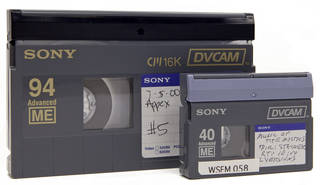

- Synonym
-
- Digital Video (ambiguation)
- Dates
- 1996 – present
- Common Size(s)
- Tape width: ¼"
- Cassette, small: 2½" × 1⅞" × ½" / cassette, large: 4⅞" × 3" × ½"
- Description
- DVCam is a magnetic tape-based digital video cassette format. The tape is composed of magnetic particles, a binder, and a polyester base. Large cassettes measure 4⅞" × 3" × ½", are for use in recording and editing decks, and have an available recording length of about 184 minutes. Small cassettes measure 2½" × 1⅞" × ½" and are for use in cameras, and have an available recording length of up to 40 minutes. The cassettes are generally bluish gray in color with 'DVCAM' printed on the upper right-hand corner.
- Composition
- Polyester magnetic tape enclosed in a plastic cassette
- Deterioration
- DVCam is subject to the same physical issues as analog tapes—stretching, breaking, drop-outs, mold, binder deterioration, and unintended recording. Presently, market share suggests a lessened threat to obsolescence. However, as with any newer video format, it is difficult to predict how long it will be supported. The size and durability of DVCam is a concern. DVCam is a higher quality product than older mini formats like Hi8, and it is comparable to DVCPro.
- Risk Level
- As with most magnetic media, DVCam is subject to the threat of obsolescence; its present market share, however, suggests that this threat is relatively low. Although DVCam is not an archival format, reformatting is not an immediate preservation priority unless there are obvious signs of tape failure.
- Playback
- DVCam cassettes require format-specific equipment for playback.
- Background
- DVCam was introduced in 1996. It was developed by Sony for industrial, educational, and professional markets. It is presently used extensively for electronic news gathering, cable television, and other field production. It is also used as a mastering format by artists and independent producers, especially for long-form programming (e.g. documentaries) because the maximum tape length on a single cassette is 184 minutes.
- Storage Environment
-
Allowable Fluctuation: ±2°F; ±5% RH
Ideal Acceptable Temp. 40–54°F (4.5–12°C) 55–60°F (13–15.5°C) RH 30–50% RH - Storage Enclosure(s)
-
Acid-free enclosures are strongly advised. Each item should have its own enclosure to protect it from dust, handling damage, and changes in environmental conditions. All storage materials should pass the Photographic Activity Test (PAT) as specified in ISO Standard 18916:2007 and must be chemically and physically stable.
- Plastic: Polyethylene, polypropylene, or polyester (a.k.a. Mylar D or Melinex 516). No PVC or acetate.
- Paper/Paperboard: Neutral pH, lignin-free, buffered materials recommended.
Inert plastic containers are ideal. If housed in a plastic container and you are unsure if it is acceptable, check the condition of the container. The container is acceptable if it is protecting the media from dust, pests, and other contaminants; is not shedding or introducing any contaminants through its own degradation; and, is clean and free of mold or excessive dirt. Anything other (e.g. a cardboard or thin plastic slipcover) than a hard plastic container means that it is not sufficiently protected and that it should be rehoused in a clean, inert plastic container.
An enclosure must be truly clean in order to protect the fragile tape surface. Dust and dirt abrasions can affect sound quality and even render the tape unplayable. Moldy, damaged, and dirty containers must be replaced.
- Storage Orientation
- The best orientation for a cassette is vertical on its end. Cassettes and cartridges, generally speaking, like to be stored upright on shelves like books. Piling tapes one upon the other tends to stress the cassettes at bottom; and over time, this can cause the plastic housing to warp and even crack. Allowing cassettes to lean for too long in a suboptimal environment can also lead to distortion. Wood cabinets should be avoided. Enameled steel, stainless steel, or anodized aluminum are preferred.
- Handling/Care
- Engage the record protection mechanism if it has not already been done. Do not attempt to open a tape cassette/cartridge; this is likely to cause greater damage unless you know what you are doing. Furthermore, never touch the magnetic tape surface. Keep magnetic media away from stray electromagnetic fields; avoid devices with a motor or transformer, both of which generate an alternating magnetic field. Never leave media in a playback machine; always return to storage enclosure when not in use. For more information about protection mechanisms, see Playback.
Other Digital Video Cassettes
D-1
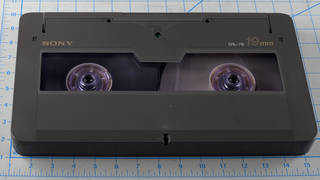
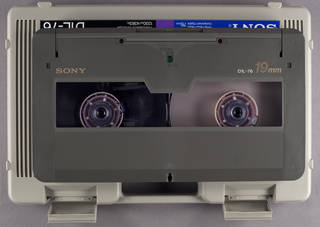
- Description
- D-1 was introduced in 1986 and is the first digital videotape format. The tape itself is ¾" wide. Digital video for much of the early 1990s was very expensive and required significant infrastructural investments. D-1 was a fairly niche format, seeing most adoption in animation and motion graphics. Unlike its standard definition digital video successors, D-2 and D-3), D-1 stored uncompressed digital component video, which recorded three signals in standard definition. Digital Betacam was the main competitor to Sony's D-1.
- External Resources
Betacam SX
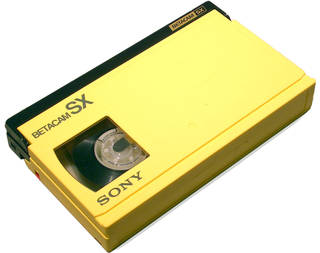
- Description
- Betacam SX can be thought of as a transitional format, the budget digital version of Betacam SP: cheaper than Digital Betacam and compatible with SP tapes. Betacam SX cassettes and their cases are bright yellow. Broadcasting archives of the mid 1990s to 2000s are likely to contain SX cassettes and possibly SX recordings on analog SP tapes.
- External Resources
HDCAM / HDCAM SR

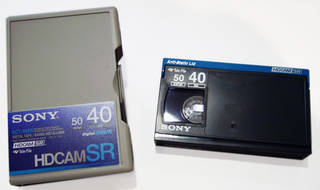
- Description
-
HDCAM was introduced in 1997 as the high-definition version of Digital Betacam. Like others in the Betacam family, HDCAM came in both small and large cassette profiles. Small HDCAM cassettes bear resemblance to the original Betamax casing. Panasonic's DVCPro HD was the HDCAM's competitor of this early era of high-def video.
HDCAM SR was introduced in 2003 with increased bit rate capacity and higher particle density tape composition. Since the late 2000s, HDCAM SR has been used for HDTV television production. HDCAM tapes are black with an orange tape guard; HDCAM SR tapes are black with cyan.
- External Resources
HDV

- Description
- HDV is a high-definition video format encoded on a DV cassette. HDV was introduced in 2003 through a partnership of Sony, Canon, JVC, and Sharp ("HDV" is a joint trademark of Sony and JVC). Most HDV camcorders use small MiniDV-sized cassettes, but HDV come in both large and small cassette profiles. The primary difference between the two is simply the recording time. The more significant division among HDV is between resolution and scanning type: HDV 720p (progressive scan) and HDV 1080i (interlaced). Since about 2006, support for HDV has progressively receded.
- External Resources
Resources
- Forgas, L. (1997). The preservation of videotape: Review and implications for libraries and archives. Libri, 47(1), 43-56.
- Texas Commission on the Arts. (2004). Texas Commission on the Arts videotape identification and assessment guide. Retrieved from: http://www.arts.texas.gov/wp-content/uploads/2012/04/video.pdf
- For additional resources, see Audiovisual (General) and Moving Image.